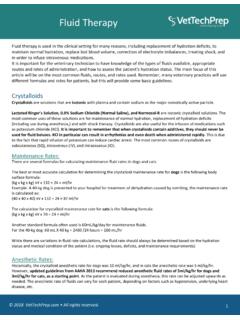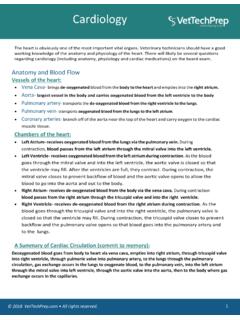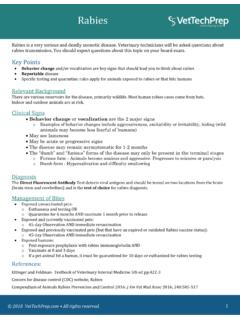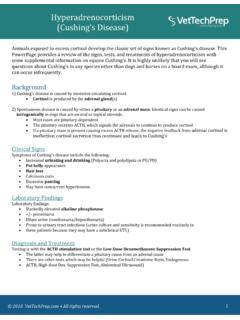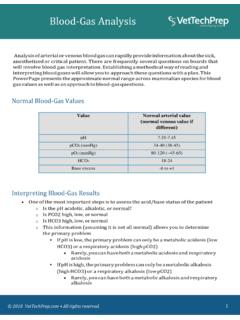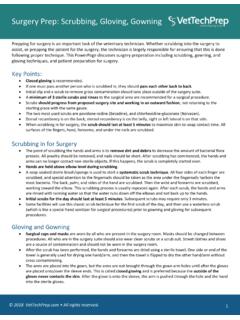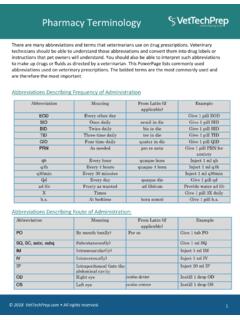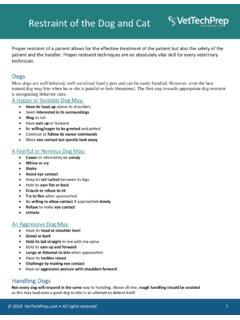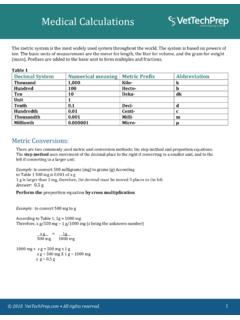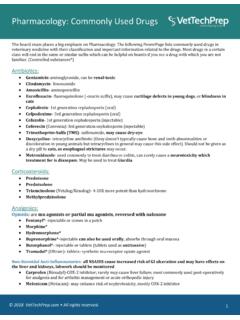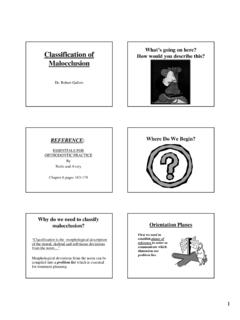Transcription of Anesthetic Induction and Recovery - VetTechPrep
1 Anesthetic Induction and Recovery Induction and Recovery are the two times during an Anesthetic episode where a patient s state of consciousness is altered. During Induction a patient is transferred from a state of consciousness to a state of unconsciousness and the process is reversed during Recovery . It is important to understand signs, equipment, and methodology to make this transition for the patient as easy as possible and to avoid unnecessary complications. Induction Routes of Delivery: Injectables vs. Inhalants Injectables: Usually the preferred method of Induction ; patients are usually less stressed due to the fast-acting nature of the drugs.
2 More than one drug can be given and more than one route can be used to deliver the Induction agents Some injectable drugs can be given intravenously or intramuscularly The downside to injectable agents is that once they are given they cannot be controlled and are not immediately eliminated. Intramuscular injections take longer to work and are used for animals that are hard to handle. Inhalants: Often the patient that is induced with inhalants experience a prolonging of stage two of anesthesia, also known as the excitement phase.
3 During stage two of anesthesia the animal can become anxious, especially if no premedication is used. Gas Induction can be the best choice for animals that are too aggressive to touch or who are very small (although this is usually avoided when possible). Inhaled agents can be delivered to the patient in two ways, by holding a gas mask up to the patients face or placing the patient in a sealed chamber where the animal is immersed in inhalant Anesthetic . When using the chamber, it is important to make sure the chamber is big enough for the patient to lay down with an extended neck.
4 High oxygen flow rates of 3-5 liters per minute and high gas concentrations of 3-4% for isoflurane and 4-5% for sevoflurane are used to speed up Once the animal appears anesthetized, remove the animal from the chamber and attempt endotracheal intubation. If the patient is not adequately anesthetized to allow for intubation, a mask can be used to administer more Anesthetic gas to deepen the Anesthetic plane. Compared to the chamber, the gas mask method exposes the anesthetist to less Anesthetic . When using mask Induction , start the vaporizer setting at and increase in increments every 30 seconds until the patient is sedate to reduce the animal s stress.
5 When using this method be sure to use the appropriate size mask and diaphragm to reduce the amount of dead space and gas leakage. Common Injectable Induction Agents: It is imperative to know the history of the animal before choosing an Anesthetic drug protocol. Disposition, concurrent health problems, health status, and reason for anesthesia will aid in deciding the safest and appropriate Anesthetic Induction protocol for the patient. Pre-medicating the patient prior to Induction will also lessen the amount of Induction drugs needed to sedate the patient.
6 2018 All rights reserved. 1 Propofol o Rapid Acting. o Quickly eliminated from the body by hepatic and extrahepatic metabolism. o Potent respiratory depressant that can cause apnea after Induction . o Can cause hypotension due to vasodilatation. o Does cross the placental barrier but with minimal depressant effects on the fetus. o Intravenous administration only. Etomidate o Rapid Acting. o Produces a hypnotic like state that doesn t completely sedate the patient and therefore, inductions can be rough. o Eliminated by hepatic metabolism.
7 O Administration can be painful due to the propylene glycol carrier. o Cardiovascular system is unaffected by this drug. o Does cross the placental barrier but with minimal depressant effects on the fetus. o Intravenous administration only. Benzodiazepines o The most common benzodiazepines used for Induction are diazepam, midazolam, and zolazepam. o Reduce anxiety and provide skeletal muscle relaxation. o Always given with another Induction agent because they do not provide sedation and may cause excitement. ( ketamine and diazepam are usually given together) o Eliminated by hepatic metabolism.
8 O Diazepam contains propylene glycol which can be irritating to the tissues and causes the drug to have an unreliable absorption rate when given intramuscularly. o Diazepam is not water soluble and can only be mixed in a syringe with ketamine. o Zolazepam is the benzodiazepine part of the mixture known as Telazol. o Can be given intravenously or intramuscularly. Cyclohexamines o The two most common cyclohexamines used for Induction are ketamine and tiletamine. o Stimulate the central nervous system rather than depress it like most other Induction drugs.
9 O Produces muscle rigidity and sensitivity to light, sound, and touch. These effects can be reduced by using other drugs in combination with the cyclohexamine. o Increases heart rate, blood pressure, and intraocular pressure. They are not recommended for patients with ocular disease. o Recovery can be rough as patients tend to be dysphoric. o Ketamine is metabolized via the liver in the dog and kidney in the cat. Tiletamine is metabolized via the kidneys in both animals. o Tiletamine is the cyclohexamine part of the mixture known as Telazol.
10 O Can be given intravenously or intramuscularly. Barbiturates o The two most common barbiturates used for Induction are thiopental and methohexital. o Rapid onset of action. Anesthetic Machine Components 2018 All rights reserved. 2 Anesthetic Induction and Recovery o Causes respiratory and cardiovascular depression. o Metabolized hepatically and extrahepatically. o Redistributes to highly lipid areas of the body. Use with caution in lean animals, such as sighthounds, as low levels of body fat will produce more pronounced central nervous system depression.
